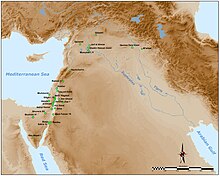 | |
  | |
| Location | West Bank |
|---|---|
| Coordinates | 31°38′00″N 35°15′00″E / 31.633333°N 35.25°E / 31.633333; 35.25 |
| History | |
| Periods | Mesolithic, Neolithic |
| Cultures | Khiamian |
| Site notes | |
| Excavation dates | 1931, 1957, 1961 |
| Archaeologists | R. Neuville, André Parrot, Joaquín González Echegaray |
| Public access | Unknown |
El Khiam (الخیام) is an archaeological site near Wadi Khureitun in the Judaean Desert in the West Bank, on the shores of the Dead Sea.
Archaeological finds at El Khiam show nearly continuous habitation by groups of hunters since the Mesolithic and early Neolithic periods. The Khiamian period (c. 10000–9500 BCE), named for this site, is characterized by flint arrowheads now known as "El-Khiam points". El Khiam was first excavated by René Neuville in 1934, by Jean Perrot in 1951 and Joaquín González Echegaray [es] in 1961.
Gallery
-
 El-Khiam point microlith, first found at El Khiam.
El-Khiam point microlith, first found at El Khiam.
-
 Three El-Khiam points.
Three El-Khiam points.
References
- Archaeological Encyclopedia of the Holy Land, Avraham Negev and Shimon Gibson
- ^ Gopher, Avi., Arrowheads of the neolithic Levant: a seriation analysis, p. 6 & 9, Dissertation Series 10, American Schools of Oriental Research, Eisenbrauns, 1994.